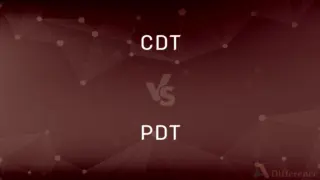ISBN 10 vs. ISBN 13 — What's the Difference?
By Tayyaba Rehman — Published on January 25, 2024
ISBN 10 is a 10-digit International Standard Book Number used until 2007. ISBN 13 is a 13-digit code introduced in 2007 for greater accuracy and global compatibility.

Difference Between ISBN 10 and ISBN 13
Table of Contents
ADVERTISEMENT
Key Differences
ISBN 10, the older system, consists of 10 digits and was the standard format for book identification until 2007. It includes a group identifier (like country or language), a publisher code, an item number, and a check digit. ISBN 13, introduced in 2007, expanded the format to 13 digits to increase the capacity for new ISBNs and align with global product identification standards (EAN). It also includes a prefix element (typically "978" or "979").
The transition to ISBN 13 was primarily driven by the need for more numbers to accommodate the growing number of publications worldwide. While ISBN 10 was sufficient for many years, the book industry's expansion necessitated a longer code. ISBN 13 is compatible with the global EAN barcode system, making it more suitable for international trade.
In terms of calculation, the check digit in ISBN 10 is derived using a modulus 11 algorithm, which can result in the check digit being a number or 'X'. ISBN 13 uses a modulus 10 algorithm, where the check digit is always a number. This difference in check digit calculation reflects the systems' adaptation to the respective length and format requirements.
For publishers and booksellers, ISBN 13 offers a more standardized and globally recognized system. While ISBN 10 codes can be converted to ISBN 13 (usually by adding the prefix "978"), new books are exclusively assigned ISBN 13 numbers. The transition to ISBN 13 reflects the publishing industry's adaptation to global digitization and the increased volume of publications.
Comparison Chart
Length
10 digits
13 digits
ADVERTISEMENT
Introduction
Standard until 2007
Introduced in 2007
Format
Group code, publisher, item number, check digit
Prefix, group code, publisher, item number, check digit
Check Digit Algorithm
Modulus 11
Modulus 10
Global Compatibility
Limited, primarily pre-2007 publications
Aligned with EAN, suitable for international use
Compare with Definitions
ISBN 10
10-Digit Code
The ISBN 10 of my old textbook is 0-306-40615-2.
ISBN 13
Check Digit Algorithm
ISBN 13 uses a modulus 10 algorithm for its check digit.
ISBN 10
Legacy System
Many libraries still catalog books using ISBN 10 numbers.
ISBN 13
Expanded Capacity
The switch to ISBN 13 was necessary to accommodate more books.
ISBN 10
Publisher Identification
The ISBN 10 uniquely identifies the book's publisher.
ISBN 13
13-Digit Code
The ISBN 13 for the new novel is 978-3-16-148410-0.
ISBN 10
Check Digit Calculation
In ISBN 10, the check digit is calculated using modulus 11.
ISBN 13
EAN Compatibility
ISBN 13 is aligned with the EAN barcode system for international use.
ISBN 10
Pre-2007 Standard
ISBN 10 was widely used before the introduction of ISBN 13.
ISBN 13
Post-2007 Standard
ISBN 13 has been the standard format for books published after 2007.
Common Curiosities
What is ISBN 10?
ISBN 10 is a 10-digit International Standard Book Number used for book identification until 2007.
Do eBooks require an ISBN?
Yes, eBooks also require an ISBN, typically an ISBN 13.
Are ISBN 10 and ISBN 13 numbers unique to each book?
Yes, both ISBN 10 and ISBN 13 provide unique identifiers for each book edition.
Is ISBN 13 mandatory for all books?
Yes, since 2007, ISBN 13 is the mandatory format for all newly published books.
Is the publisher information included in both ISBN 10 and ISBN 13?
Yes, both formats include a segment for publisher identification.
Can ISBN 10 still be used for new books?
No, new books are assigned ISBN 13 numbers for global compatibility.
How can I convert ISBN 10 to ISBN 13?
You can convert ISBN 10 to ISBN 13 by adding the prefix "978" and recalculating the check digit.
Do old books have ISBN 13 numbers?
Books published before 2007 typically have only ISBN 10 numbers unless reprinted.
Why was ISBN 13 introduced?
ISBN 13 was introduced to increase the number of available identifiers and align with the EAN barcode system.
What is the modulus algorithm used in ISBN?
It's a mathematical method used to calculate the check digit in ISBN codes.
What is ISBN 13?
ISBN 13 is a 13-digit International Standard Book Number introduced in 2007 for global book identification.
Does the ISBN contain information about the book content?
No, the ISBN is purely an identifier and does not encode content information.
Can two books have the same ISBN number?
No, each edition of a book has a unique ISBN number.
How does the ISBN help in book cataloging?
ISBNs assist in the efficient cataloging and retrieval of book information in libraries and bookstores.
Are there any books with both ISBN 10 and ISBN 13?
Books published around the transition period may have both ISBN 10 and ISBN 13.
Share Your Discovery

Previous Comparison
JSP vs. JavaScript
Next Comparison
CDT vs. PDTAuthor Spotlight
Written by
Tayyaba RehmanTayyaba Rehman is a distinguished writer, currently serving as a primary contributor to askdifference.com. As a researcher in semantics and etymology, Tayyaba's passion for the complexity of languages and their distinctions has found a perfect home on the platform. Tayyaba delves into the intricacies of language, distinguishing between commonly confused words and phrases, thereby providing clarity for readers worldwide.












































